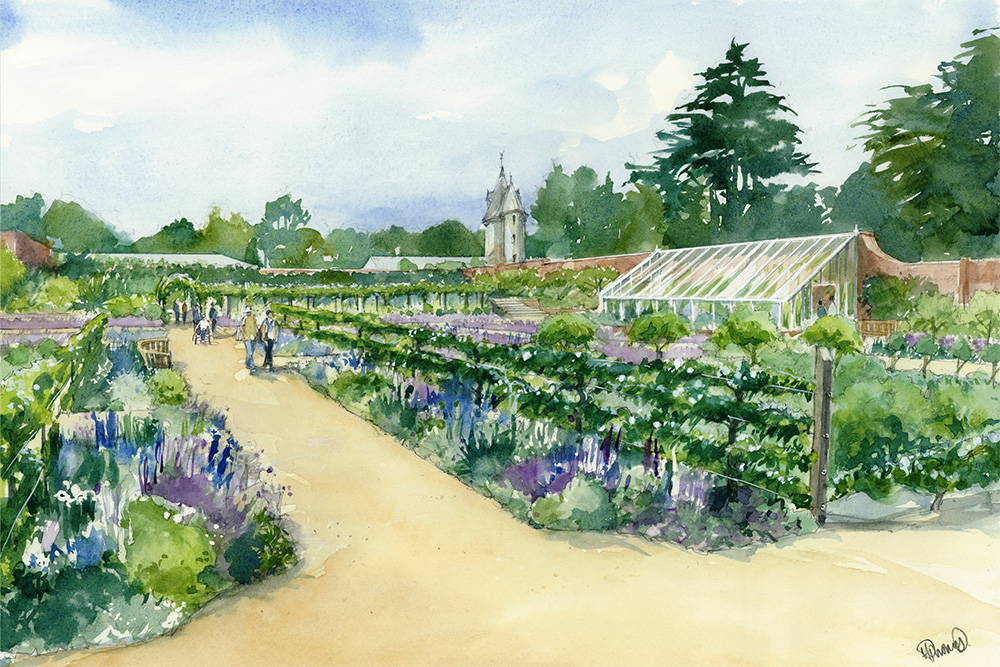Initiative Overview
In 2025, Royal Oak is raising money to help the National Trust restore the glasshouse in the walled garden at Trelissick in Cornwall.
A Glorious New Glasshouse for Trelissick in Cornwall
In 2025, Royal Oak is raising money to help the National Trust restore the glasshouse in the walled garden at Trelissick in Cornwall.

Artist’s rendering of Trelissick/ Helen Thomas Cookson & Tickner
“Most horticulturalists know Trelissick as the fruit garden of Cornwall. Here, if anywhere, peaches and nectarines, plums and pears, and other kinds of fruit are brought to the acme of perfection.”—F. Hamilton Davey, Royal Cornwall Gazette, 1897
The historic house and gardens of Trelissick estate command stunning maritime and countryside views from atop a peninsula in the far southwest of England, near the city of Truro, Cornwall. The house, a grade II-listed property, was originally built in 1755 by Edmund Davy and lies within the Cornwall Area of Outstanding Natural Beauty.
In 1955, the entire 300-acre property was gifted to the National Trust by its last private owners, the Copeland family. Ida Copeland, the final matriarch, was from a family of Italian bankers and was a second cousin of Florence Nightingale.
Built in the mid-18th century, Trelissick’s walled garden became synonymous with a pursuit of horticultural excellence. However, the property’s magical two-acre kitchen garden – once the productive heart of the estate – has sat dormant and inaccessible for decades.
Today, the Trust wants to make Trelissick’s walled garden a hub of horticulture once again – only this time, growing an impressive array of traditional and exotic fruits. The garden will inspire gardeners, showcase sustainable gardening practices, and pass gardening expertise from generation to generation.
The Royal Oak Foundation is raising $300,000 to reinstate the glasshouse to act as the focal point of the garden. Within this beautiful and functional new glasshouse, gardeners will cultivate the exquisite peaches and nectarines for which Trelissick was once famed.
The glasshouse will not only be the heritage centerpiece, but will also have an important forward-looking role, helping the Trust explore the following:
“The glasshouse is the key historical element that will bring Trelissick’s gem of a walled garden back to life in all its former glory.”—John Lanyon, Head Gardener, Trelissick
The garden will thrive as a fully productive garden once more. Within its walls, the Trust will pay homage to the garden’s glorious past while creating new relevance for the future, celebrating people, place and produce.
For People: The project will transform a neglected walled garden into a multi-sensory experience where people can explore, learn and discover. The Trust will cultivate and grow a wide variety of crops to share with visitors, as well as share the many methods and techniques needed to grow, train and harvest fruit.
For Place: The reimagined walled garden will provide a space in which to share both its fascinating history and exciting future as the productive heart of the estate. The aim is to retain the look and feel of the traditional walled kitchen garden as it once was, while ensuring it is ready to adapt to the future.
For Produce: With your support, top quality fruit will be cultivated and picked, then once again served in the house, as it was for centuries. The fruit produced in the garden will supply Trelissick’s on-site restaurant and will be served at a variety of tasting events throughout the year. They will cultivate traditional fruits such as apples, pears, and blackcurrants, including famous Cornish varieties like Cornish Gilliflower dessert apples and the Kea plum, as well as some of the garden’s historic signature fruits, like peaches.
Please check your membership status in My Account and click the Renew button if your membership has not lapsed.